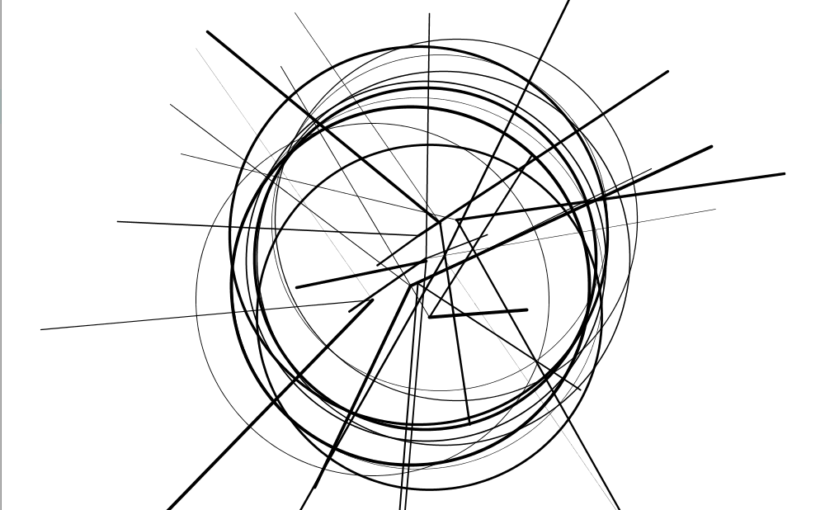Different sounds for different note values.
Tag: algorithmic composition
Musical flow machines
A misconception by people unfamiliar with algorithmic composition ist that it’s about removing the musician from the music making process. For me it’s the opposite: it’s a mechanism for creating flow, a constant feedback loop between having an intuition, abstracting it into rules and the sound resulting from that abstraction. Classic composition lacks that rapid feedback element: having an idea, writing it down. Eventually musicians will play it and you’ll learn from that, or you use a music notation software to play it back to you. But for me nothing creates a dance like creating a simple system and then observing and reacting to its behaviour in real time. You’re alert, always on edge in the most positive sense.
See also: What I’m learning from learning to juggle [Updated: July 9, 2018]
Once or twice each month I share more thoughts, essays and materials related to the blog on my newsletter, which you can subscribe to here.
Image credit: Cogwheels and pebbles by Carlos Lorenzo
Generous and generative
Today I’m thinking about generativity – generative music, generative arts, generative principles in life.
I’m also thinking about generosity – in the arts, among artists, or anywhere in life.
Both concepts share a common Greek root – “gene-“: to beget, to give birth.
To look into yourself is often misunderstood as a selfish act – something for dreamers and snowflakes. But to generate art is to be generous: to share the insights your reflections bring forth so they can enable even more insights.
Generative processes create an abundance of variations and possibilities – for the creators and for the recipients. So does generosity.
Sometimes things just make sense.
Once or twice each month I share more thoughts, essays and materials related to the blog on my newsletter, which you can subscribe to here.
New album: Possibilities Vol. 1
I tend to not use this space for personal announcements (that’s what my monthly newsletter is for), but I think a new album merits a post: Erik Emil Eskildsen and I have released Possibilities Vol. 1, an album of ambient compositions recorded in early 2016 and produced in the fall of last year. Click below to listen and purchase, and read more here.
Setting a reminder is an act of composition
Setting a reminder on your phone is an act of composition: deciding and initiating that a certain thing is to happen – and, literally, a sound is to be played – at a certain point in the future.
Setting multiple, even many, such reminders creates a polyphony, a polyrhythm of intentions. Such an approach lends itself to systematization and automation.
Taking a systematic, flexible and thus generative approach to handling our intentions, commitments and observations is to move towards a life in which these can begin to resonate with each other: a move towards integrity and growth.
Davos, December 29, 2017 / Biel, January 3, 2018
Composition Exercise #58
When working with a MIDI track: duplicate it, including all MIDI information, instrument and other settings.
Select three pitches, either randomly or by ear.
On the first track, delete all the notes with the chosen pitches.
On the second track, delete all notes except the ones with the chosen pitches.
Subtly change the instrument, effect or other settings on one of the tracks.
Repeat the procedure for every voice in your piece, making new pitch selections and applying different parameter changes for each track.
Sign up for the a100ql newsletter where I share news, thoughts, essays and materials related to the blog once or twice per month.
Instant Satie
I’m finishing a kind of “Instant Satie” Max patch for a workshop with kids visiting the Music and Media Arts facilities tomorrow. There will be three 40 minutes blocks that each group of 4-5 students will take turns to visit. Two of them will deal with live electronics and voice recoring and editing, respectively. In my part of the course we’ll listen to Erik Satie’s “Vexations” and learn about his idea of a musique d’ameublement. We’ll then use the studio’s Yamaha Disklavier (a MIDI-controllable grand piano) to create a kind of generative musique d’ameublement where three players interact with each other to steer an algorithm that will play the instrument. One player will play the piano itself and in doing so feed the computer with pitch and velocity data. The two other players, one on an iPad and one on a laptop, will select the number of notes that the computer will memorize the pitch and velocity of, and in what order, speed, transposition, and with what kind of velocity variations and polyphony it will generate derivatives and send them back to the piano in real time – while the pianist is already playing even more notes for it to learn. Here’s a screenshot from the tryouts I did this afternoon. I’ll be sharing an mp3 of what you see here with my email list later this week.
It’s not blogging but it’s a start. After two months of rehearsing and performing with pulp.noir this is the third new course I’m teaching within only five days. I hope to be writing more on this site soon – starting with the other two workshops.
Subscribe to the blog and sign up for the accompanying email newsletter where I share further thoughts, essays and materials related to the blog 1-2x per month.


